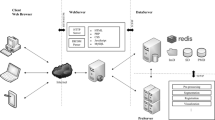Abstract
The electronic health record (EHR) is expected to improve the quality of care by enabling access to relevant information at the diagnostic decision moment. During deployment efforts for including images in the EHR, a main challenge has come up from the need to compare old images with current ones. When old images reside in a different system, they need to be imported for visualization which leads to a problem related to persistency management and information consistency. A solution consisting in avoiding image import is achievable with image streaming. In this paper we present, evaluate, and discuss two medical-specific streaming use cases: displaying a large image such as a digital mammography image and displaying a large set of relatively small images such as a large CT series.




Similar content being viewed by others
References
IHE Technical Framework and Supplements. [Online] Available http://www.ihe.net/Technical_Framework/index.cfm. Accessed 2 March 2010.
Taubman D, Prandolini R: “Architecture, philosophy, and performance of JPIP: internet protocol standard for JPEG2000.” In: Proc. International Symposium on Visual Communications and Image Processing (VCIP ‘03), vol. 5150 of Proceedings of SPIE, Lugano, Switzerland, July 2003, pp 791–805.
Lima L, Taubman D, Leonardi R: JPIP proxy server for remote browsing of JPEG2000 images, IEEE 10th Workshop on Multimedia Signal Processing (MMSP), 2008, pp 844–849.
The Digital Imaging and Communications in Medicine (DICOM) Standard. [Online] Available http://medical.nema.org. Accessed 2 March 2010.
Noumeir R, Pambrun JF: Images within the Electronic Health Record, IEEE International Conference on Image Processing, 2009, pp1761–1764.
Taubman D, Marcellin MW: JPEG 2000: Image compression fundamentals, standards and practice. Kluwer Academic Publishers, Norwell, MA, 2001
Koff D, Bak P, Brownrigg P, Hosseinzadeh D, Khademi A, Kiss A, Lepanto L, Michalak T, Shulman H, Volkening A: Pan-Canadian evaluation of irreversible compression ratios (“lossy” compression) for development of national guidelines. Journal of Digital Imaging 22(6):569–578, 2009
Noumeir R, Pambrun JF: Streaming of medical images using JPEG 2000 interactive protcol, IWSSIP 2010 17th international conference on systems, signals and image processing, to appear, 2010.
Acknowledgment
This work was supported by a grant from Canada Health Infoway and the Government of Quebec.
Author information
Authors and Affiliations
Corresponding author
Appendix: Introduction to JPEG 2000
Appendix: Introduction to JPEG 2000
JPEG 2000 is an image compression method based on the discrete wavelet transform (DWT). The DWT is specified by a pair of two linear filters, a high-pass filter and a low-pass filter. In JPEG 2000, two types of filters are used, the Daubechies 9/7 and Le Gall 5/3 filter; the latter is used for lossless compression because it generates integer values. When those filters are applied on an image, four subbands are generated; they contain the output of the filters, the wavelet coefficients:
-
Applying the low-pass filter on both the rows and columns generates a lower resolution image (LL).
-
Applying the low-pass filter on one direction and the high-pass filter on the other direction generates a subband that contains coefficient for low frequency in one direction and high frequency in the other direction respectively (HL and LH).
-
Applying the high-pass filter on both directions generates a high frequency subband (HH).
The subbands are half the size of the original image because the decomposition includes a subsampling by two. The low-pass subband represents a smaller low-resolution version of the original image. The high-pass subbands represent high frequency information that is needed along with the low-pass subband for a perfect reconstruction of the original image.
The decomposition of the low frequency subband can be repeated (Fig. 5), and there is no restriction on the number of decomposition other than the size of the image itself.
JPEG 2000 allows progressive decompression. One straightforward scheme is to start with the low-pass image at the lower decomposition level, add all subbands from the upper decomposition level to reconstruct a new low pass and so on until the complete image is reconstructed.
Full Resolution Region of Interest and Space–Frequency Localization
The wavelet transform has an important property known as the space–frequency localization; this comes from the fact that contiguous pixels in the original image are transformed into contiguous wavelet coefficients in each of the four subbands (Fig. 6).
Precincts and Progressive Reconstruction of a Region of Interest
In order to achieve a progressive reconstruction of a specific region, JPEG 2000 allows a subband to be subdivided into rectangular regions. For each rectangular region in the LL subband, there are three rectangular regions, one in each of the higher frequency subband. This set of three regions is called a precinct (Fig. 7).
Precincts from all decomposition levels that form a specific spatial region are used to reconstruct a full resolution region. Precincts are important for interactive navigation. In fact, if we are interested in panning into a large image, only the precincts that correspond to the viewing window need to be transferred. In case where the window overlaps multiple precincts, all of the overlapped precincts would be needed.
Rights and permissions
About this article
Cite this article
Noumeir, R., Pambrun, JF. Using JPEG 2000 Interactive Protocol to Stream a Large Image or a Large Image Set. J Digit Imaging 24, 833–843 (2011). https://doi.org/10.1007/s10278-010-9343-0
Published:
Issue Date:
DOI: https://doi.org/10.1007/s10278-010-9343-0







